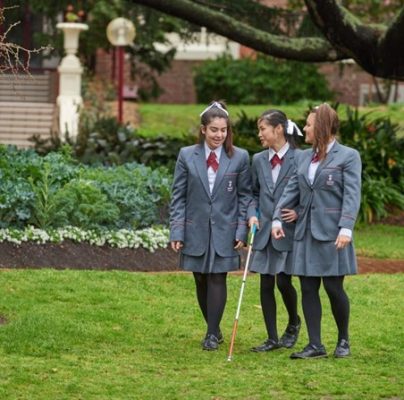Cane techniques, echolocation, intuition, memory and planning – enables Thanh to overcome these challenges
Written by: Ngoc Autran, Access Consultant, Architecture & Access
Last month our team at Architecture & Access spoke to Thanh Autran about how she overcomes the challenges involved in her day-to-day life as a vision impaired commuter.
Thanh Autran is student studying her Bachelor of Health Sciences at Monash University, she was diagnosed with Bilateral Sclerocornea at age 3 and has lived her whole life as a legally blind individual.
Despite her lack of vision Thanh has excelled in her studies at Genazzanos FCJ College graduating Year 12 VCE with an ATAR of 97. She has represented Victorian Youth team in the National Goalball Championships for several years, dabbles with ceramics and is a self-taught guitarist.
After several years of extensive Orientation & Mobility training with Guide Dogs Victoria, she now commutes autonomously from Melbourne’s west to the Caulfield campus most days of the week to study.
As a blind individual, Thanh heavily depends on public transportation to get around. She employs several techniques and strategies to commute safely in the built environment.
Although she
uses her cane there are often mobile and unmanaged obstacles that are difficult
to anticipate.
To compensate for moving obstacles, she relies on her intuition and ability to
commit landmarks to memory.

Thanh applies a range of cane techniques to pick up on tangible cues in the built environment such as Tactile Ground Surface Indicators (TGSIs) and Architectural elements such as columns, floor to wall transitions and stairs. She combines these techniques with echolocation and intuition. She uses echolocation to determine spatial dimension such as ceiling heights, room widths and lengths. She pays particular attention to the junctions between these spaces to predict her position and within her environment. Lastly, her intuition is used to predict mobile obstacles such as people, loose furniture, or construction barriers in public spaces.
The layering of these skills helps Thanh to travel from Melbourne’s West to Monash University, however there are many unforeseeable issues that are harder to account for during her commute. In her route to the bus stop, Thanh orientates herself along the path by shore lining the building fences and nature strips. She often interchanges between the two depending on the level of maintenance. She uses the kerbs and TGSIs to find her way to the bus stop shelter and identify the roadway. When the bus drivers forget to stop at end of the TGSIs, Thanh pays attention to the sound of the bus doors opening and the footsteps of people moving towards the same direction.
In the train station, the acoustics produced by the trains, stairs, speakers, and people can be overstimulating during the day. In these scenarios Thanh relies on her memory of the building layout to get to the MYKI barriers. Between the train station and the Monash University campus Thanh’s most effective wayfinding ability relies on detecting changes in floor surface materials. The changes in floor material can be felt through her shoes. Floor materials play a big role in assisting vision impaired individuals with wayfinding because they are also the most consistent and stationary elements in every environment.
Although overly stimulating spaces prove to be a challenge at times, Thanh struggles particularly in big open spaces. Open spaces generally don’t have enclosed walls or ceilings for effective echolocation, loose furniture that are movable or not arranged in logical order and can sometimes be too crowded for her to use her cane. In addition, some scenarios such as construction works or public events without sufficient warnings make these environments trickier to navigate and creates confusion, it becomes particularly dangerous when barriers are not placed between the footpath and the road. The traverse through open spaces can be confusing and disorientating when all these factors are present. Thanh often plans her trips ahead of time to ensure she avoids big crowds, open spaces, and unexpected events to get to her classes safely.
Since Thanh relies heavily on her ability to memorize her routes and their dangers, she needs to interchange between cane techniques, echolocation, and intuition, this means she becomes very selective with her capacity to commit environmental elements to memory which advances to muscle memory over time. She appreciates when loose furnishings are organised in a logical manner and maintained to ensure a clear and direct path of travel to prevent collisions. An important focal point of wayfinding for people with vision impairments relies on having obvious environmental cues and landmarks as well as ensuring they are well organised, maintained, and managed.
Although a range of assistive technologies are available, Thanh finds her skillsets to be more accurate and agile for the built environments. She mentions that these technologies can hinder her ability to pick up on important unanticipated cues to keep her safe, especially in the settings of public events and construction.
Our conversation with Thanh and her lived experience as a vision impaired individual brings forward some important features of the built environment and considerations in the design of future spaces. It is through these insights that we can guide our clients towards building more inclusive and accessible spaces for everyone.
